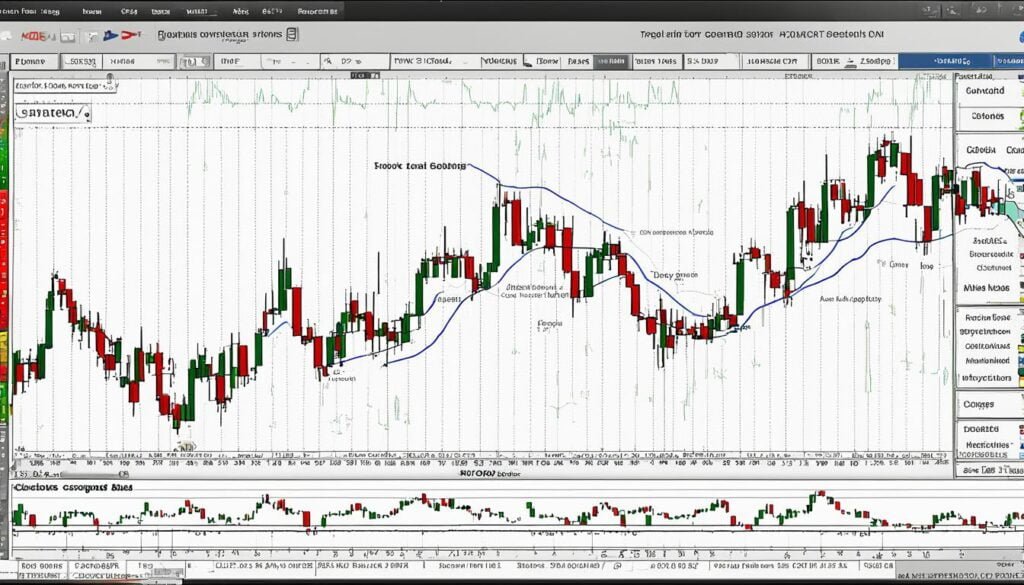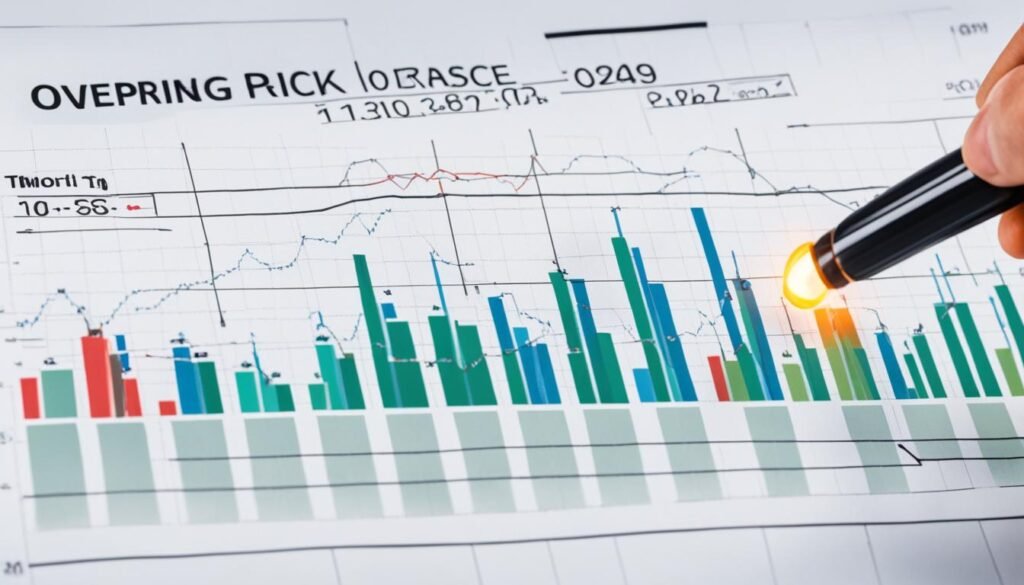Welcome to our complete guide to technical analysis for beginners. Whether you are new to trading or just looking to improve your skills, understanding technical analysis is crucial for success in the stock market. Technical analysis involves analyzing market data, such as price charts, to identify patterns and trends that can help inform trading decisions.
In this guide, we will cover the basics of technical analysis and provide you with the knowledge and tools necessary to get started with this essential trading skill. From understanding price patterns to advanced technical analysis techniques, we will take you step-by-step through the fundamentals of technical analysis.
Unlock the Secret to Forex Success with BOB James’ Top-Performing Signals! Experience the Ease of Proven, MyFXbook-Verified Strategies and Transform Your Trading Journey Today. Don’t Miss Out on Exceptional Performance – Join Now!
Key Takeaways:
- Technical analysis involves analyzing market data, such as price charts, to identify patterns and trends
- Understanding technical analysis is crucial for success in the stock market
- This guide provides beginners with a solid foundation in technical analysis
- Important topics covered in this guide include price patterns, technical indicators, trend analysis, and risk management
- Developing a personalized trading plan based on technical analysis is essential for consistent and disciplined trading
Introduction to Technical Analysis
Technical analysis is a method of evaluating securities by analyzing statistics and market activity such as price and volume. Unlike fundamental analysis, which focuses on a company’s financial and economic factors, technical analysis is solely concerned with price history and trends.
Technical analysis is an essential tool for traders because it helps to identify potential market opportunities and make informed trading decisions. By studying price patterns and technical indicators, traders can gain valuable insights into market sentiment and predict future price movements.
At its core, technical analysis is based on the efficient market hypothesis, which assumes that stock prices fully reflect all available information at any given time. Therefore, prices reflect the collective opinions of all market participants and move in trends that can be identified and capitalized on.
To begin with technical analysis, it is crucial to understand the main principles and concepts behind it. In the following sections, we will explore price patterns, technical indicators, candlestick analysis, trend analysis, support and resistance levels, risk management, backtesting, and advanced techniques, that will help you develop a foundation in technical analysis.

Understanding Price Patterns
Price patterns are the building blocks of technical analysis. By understanding price patterns, traders gain valuable insights into market behavior and can identify potential trading opportunities.
Support and Resistance Levels
Support and resistance levels are key price patterns that traders use to identify areas of potential buying and selling pressure. A support level is a price point where buying pressure is expected to be strong enough to prevent the price from falling further. In contrast, a resistance level is a price point where selling pressure is expected to be strong enough to prevent the price from rising further. By understanding support and resistance levels, traders can make informed trading decisions based on market sentiment.
Trend Lines
Trend lines are another crucial price pattern used in technical analysis. Trend lines are lines drawn on a price chart to connect two or more price points. They are used to identify the direction of a trend and to help traders make trading decisions based on trend direction. An uptrend is defined by a series of higher highs and higher lows, while a downtrend is defined by a series of lower highs and lower lows.

Chart Patterns
Chart patterns are specific price patterns used to identify potential trading opportunities. Some common chart patterns include head and shoulders, double tops and bottoms, and triangles. By understanding chart patterns, traders can anticipate future market movements and make informed trading decisions.
Putting it All Together
By combining support and resistance levels, trend lines, and chart patterns, traders can gain a comprehensive understanding of market behavior. Technical analysts use these price patterns to identify entry and exit points for trades and to manage risk. By understanding the basics of technical analysis and the importance of price patterns, traders can improve their chances of success in the stock market.
Using Technical Indicators
Learning technical analysis is all about understanding the essential concepts and tools used to analyze price movements and identify trends. Technical indicators fall under this category and are widely used by traders to measure market trends. They are mathematical calculations based on price and/or volume that traders use to gain insights into market behavior.
Technical indicators can be broadly classified into two categories:
- Lagging indicators: These indicators follow price movements and provide signals after the fact. Moving averages are a popular example of a lagging indicator.
- Leading indicators: These indicators predict future price movements. Examples of leading indicators include RSI (Relative Strength Index) and Stochastic Oscillator.
It’s important to note that no indicator can predict price movements with 100% accuracy, and relying solely on technical indicators can be risky. It is always advisable to use technical indicators in conjunction with other technical analysis tools like chart patterns and trend lines.
Some of the popular technical indicators used by traders include:
| Indicator | Type | Function |
|---|---|---|
| Simple Moving Average (SMA) | Lagging | Calculates the average price of a stock over a specified period of time and smoothens out price movements |
| Relative Strength Index (RSI) | Leading | Measures the velocity and magnitude of price movements and indicates whether a stock is overbought or oversold |
| Stochastic Oscillator | Leading | Indicates potential reversal points by comparing the closing price of a stock to its price range over a specified period of time |
| Volume Indicator | Lagging | Measures the trading volume of a stock over a specified period of time to determine the level of investor interest in the stock |

Interpreting the signals generated by technical indicators requires practice and experience. It’s advisable to experiment with different indicators in a virtual environment before implementing them in real-world trading scenarios.
Candlestick Analysis
Learning technical analysis involves understanding how to read and interpret candlestick patterns, which provide valuable insights into market sentiment. A candlestick chart is a popular way to visualize price movements and is based on the open, high, low, and close of a trading session. Each candlestick represents a trading session, and the shape and color of the candle can reveal important information about the market.
Essential concepts of technical analysis, such as support and resistance levels, can also be applied to candlestick analysis. For example, a long candlestick that breaches a previous resistance level can indicate a bullish trend, while a short candlestick that fails to break a support level can signal a bearish trend. Understanding these patterns can help predict future price movements and identify potential trading opportunities.
The most important candlestick patterns to know include:
- Hammers and Shooting Stars
- Dojis
- Bullish and Bearish Engulfing Patterns
- Morning and Evening Stars
It’s worth noting that candlestick patterns should not be relied on in isolation but should be used in confluence with technical indicators and other analysis techniques. Utilizing multiple tools and strategies can help confirm trading signals and improve decision-making.

Trend Analysis
Trends are an integral part of technical analysis. They give traders a clear understanding of the direction in which a stock is moving. Being able to identify different types of trends is an essential skill for getting started with technical analysis.
There are three main types of trends: uptrend, downtrend, and sideways trend. An uptrend is characterized by a series of higher highs and higher lows. A downtrend is characterized by a series of lower highs and lower lows. A sideways trend, on the other hand, has no clear direction and is marked by horizontal price movements.
| Type of Trend | Characteristics |
|---|---|
| Uptrend | A series of higher highs and higher lows |
| Downtrend | A series of lower highs and lower lows |
| Sideways Trend | No clear direction, horizontal price movements |
One way to identify trends is by using trend lines. A trend line is a straight line drawn across the chart that connects two or more price points. It acts as a visual guide for traders, helping them to better understand the price movements of a particular stock.
It’s important to note that trends can change, and traders need to be able to identify when a trend is reversing. This is called a trend reversal. It’s crucial to be able to recognize a trend reversal as it can signal a shift in the market direction, which could lead to potential trading opportunities.
In the next section, we will discuss support and resistance levels, which are crucial areas on a price chart that help traders predict potential market movements.
Support and Resistance Levels
In technical analysis, support and resistance levels are key concepts that can help traders identify potential reversals or breakouts in price trends. Support levels refer to the price level at which demand for a stock is strong enough to prevent it from falling further. Resistance levels represent the opposite, in which the price level is too high for buyers to continue buying, leading to a decrease in demand and potential selling pressure.
So, how can traders identify these important levels?
- Support and resistance levels can be determined by analyzing price charts and observing where price movements have stalled or reversed in the past.
- Traders can also use technical indicators, such as moving averages and trend lines, to help identify support and resistance levels.
- Fundamental analysis can also play a role in identifying support and resistance levels by assessing a company’s financial health and industry trends.
Once identified, support and resistance levels can be used to make trading decisions. Traders may look to buy at support levels and sell at resistance levels, with the expectation that the price will continue to move in the same direction as the trend. Alternatively, if a support or resistance level is broken, it could indicate a potential reversal in the trend, prompting traders to adjust their trading strategy.
In summary, support and resistance levels are essential concepts in technical analysis that can help traders identify potential trading opportunities and make informed trading decisions. By mastering the basics of support and resistance levels, beginners can gain a better understanding of the broader principles of technical analysis and improve their chances of success in the stock market.
Risk Management in Technical Analysis
Beginner-friendly technical analysis must include effective risk management strategies as trading can be unpredictable and volatile. Risk management is an essential part of trading that helps protect your capital and minimize losses.
One of the most effective ways to manage risk is to apply the 2% rule. This rule suggests that traders should not risk more than 2% of their capital on any single trade. This way, even if the trade doesn’t go as planned, the loss will be limited and can be recouped over time.
Diversification
Another effective risk management strategy is diversification. Diversifying your portfolio means spreading out your investments across different asset classes, industries, and sectors. This way, if one investment doesn’t perform well, the other investments can help balance it out. As a beginner trader, diversification can help mitigate risks as you learn more about the market.
Stop-Loss Orders
Stop-loss orders are another important tool for managing risk. These orders automatically close out a position once it reaches a certain price level, limiting potential losses. Traders can set up stop-loss orders before entering a trade, providing a predefined exit point in case the trade moves against them.
“The most important thing about risk management is not the strategy, but the discipline to follow the strategy.” – Paul Tudor Jones
Remember, even with effective risk management strategies, trading still involves risk. It’s crucial to have the discipline to follow these strategies consistently to limit your risk and increase your chances of success.
Backtesting and Practice
Backtesting is an essential tool for traders, particularly beginners, to evaluate the effectiveness of their technical analysis strategies. It involves testing a trading strategy using historical data to determine how it would have performed under various market conditions.
By backtesting a strategy, traders can identify its weaknesses and strengths before risking real capital on it. Beginners can use backtesting to practice their technical analysis skills and gain confidence in their trading strategy.
To backtest a trading strategy, beginners should follow these steps:
- Choose the time frame and markets they want to test the strategy on
- Define the entry and exit conditions of the strategy
- Use historical data to simulate trades based on the defined conditions
- Analyze the results and adjust the strategy if necessary
Practicing technical analysis skills through backtesting can also help traders refine their approach and develop a more robust trading plan.
Remember, backtesting is just one tool in a trader’s toolbox, and it should not be the sole basis for making trading decisions. It is essential to combine backtesting with other technical and fundamental analysis tools to make informed trading decisions.
Developing a Trading Plan
One of the most essential components of successful trading is having a well-thought-out trading plan. This plan should be tailored to your specific technical analysis approach and trading goals. By having a clear and concise plan in place, you can stay disciplined and focused, while also minimizing the risks associated with trading. Here are some key steps to follow when developing your trading plan:
- Determine your risk tolerance: Before placing any trades, it’s important to understand the level of risk you’re comfortable taking on. This will help you establish appropriate stop-loss and take-profit levels.
- Define your trading goals: What are you hoping to achieve through trading? Are you looking for short-term gains or long-term investment opportunities? Establishing clear goals will help you stay motivated and focused.
- Select your trading strategy: Based on your technical analysis approach, select a trading strategy that aligns with your goals and risk tolerance. This could include day trading, swing trading, or position trading.
- Establish your entry and exit criteria: Based on your trading strategy, identify specific entry and exit criteria that you’ll use to enter and exit trades.
- Develop a risk management plan: In addition to determining appropriate stop-loss and take-profit levels, it’s important to have a contingency plan in place for unexpected market movements.
- Backtest and refine your plan: Once you’ve established your plan, backtest it using historical data to see how it performs. Make adjustments as needed, based on your results.
By following these steps, you can develop a trading plan that’s tailored to your technical analysis approach and trading goals. Stick to your plan, and remember to stay disciplined and patient in your trading.
Advanced Technical Analysis Techniques
In the world of trading, understanding technical analysis can lead to better decision-making and profitable outcomes. While earlier sections examined the basics of technical analysis, this section will introduce advanced techniques to help traders dive deeper into forecasting and analysis. These techniques include:
- Fibonacci retracements
- Elliott Wave theory
- Harmonic patterns
With these techniques, traders can gain greater insights into price movements and forecast potential market trends with greater accuracy.
Conclusion
Technical analysis may seem overwhelming to beginners, but with a solid foundation in the basics, anyone can begin to gain insights into the stock market. This guide has provided an introduction to the fundamental concepts of technical analysis, including price patterns, technical indicators, candlestick analysis, trend analysis, support and resistance levels, and risk management.
Remember, technical analysis is not a guarantee of success in trading. It is a tool that can help traders make more informed decisions, but it is important to develop a personalized trading plan and practice consistently. Backtesting and incorporating advanced techniques can also enhance a trader’s analysis and forecasting abilities.
By following the principles and strategies outlined in this beginner’s guide to technical analysis, traders can begin to chart their path to smarter trading in the stock market.
Thank you for taking the time to read this guide on Technical Analysis for Beginners. We hope you found it helpful and informative.
FAQ
What is technical analysis?
Technical analysis is a method used by traders to evaluate and forecast future price movements in financial markets. It involves analyzing historical price data, charts, and various indicators to identify patterns and trends.
Why is technical analysis important for traders?
Technical analysis helps traders make informed trading decisions based on past price patterns and trends. It can assist in identifying potential entry and exit points, determining the strength of a trend, and managing risk effectively.
What are price patterns in technical analysis?
Price patterns are recurring formations or structures on a price chart that provide valuable insights into market behavior. Examples of price patterns include support and resistance levels, trend lines, and chart patterns like head and shoulders, double tops, and triangles.
What are technical indicators?
Technical indicators are mathematical calculations applied to price and volume data of a financial instrument. They provide additional information for traders to analyze price movements, identify trends, and potentially forecast future market conditions.
What are candlestick patterns?
Candlestick patterns are graphical representations of price movements within a particular time period. The shape and arrangement of candlestick patterns can indicate market sentiment and potential reversals or continuations in price trends.
How can I identify trends in technical analysis?
Trends in technical analysis can be identified by analyzing the price chart and observing the direction of price movement. An uptrend consists of higher highs and higher lows, while a downtrend consists of lower highs and lower lows. Trend lines are commonly used to visually represent and confirm trends.
What are support and resistance levels?
Support levels are areas on a price chart where buying pressure is expected to prevent prices from falling further. Resistance levels, on the other hand, are areas where selling pressure is expected to prevent prices from rising further. Traders use these levels to make trading decisions.
How can I manage risk in technical analysis?
Risk management in technical analysis involves setting appropriate stop-loss orders to limit potential losses, diversifying your trades and investments, and using proper position sizing techniques. It is important to always consider and plan for potential downside risks in trading.
What is backtesting and how does it relate to technical analysis?
Backtesting is the process of testing a trading strategy or system using historical data to evaluate its performance and profitability. Traders can use backtesting to analyze the effectiveness of their technical analysis strategies and make necessary adjustments to improve future trading outcomes.
How do I develop a trading plan based on technical analysis?
To develop a trading plan, you need to define your trading goals, set realistic expectations, determine your risk tolerance, select suitable technical analysis tools and indicators, and establish rules for entering and exiting trades. A trading plan helps maintain discipline and consistency in your trading approach.
What are some advanced technical analysis techniques?
Advanced technical analysis techniques include Fibonacci retracements, which help identify potential support and resistance levels based on mathematical ratios, Elliott Wave theory, which attempts to predict future price movements based on wave patterns, and harmonic patterns, which are geometric price formations that can provide additional trading opportunities.


